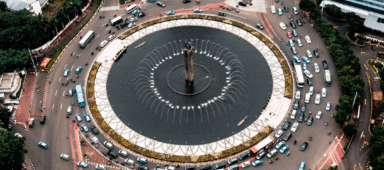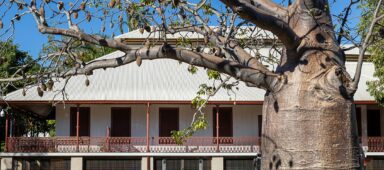There’s nowhere on earth quite like the Maldives, one of the world’s most tantalising holiday hideaways. We survey some of the latest breathtaking hotspots perfect for solo retreats, honeymoons or family adventures
Photography: ???
Few flights remotely compare with hovering over the Maldives’ iridescent, coral-fringed atolls, distant sandbars and perfect-circle lagoons in the southern Indian Ocean. It is a jaw-to-the-floor visual feast that’ll make you pinch yourself to check that you’re not dreaming.
The gateway to the Maldives is Velana Airport, which is positioned by a stunning harbour. On arrival in high season from December to April, it is permanently abuzz with activity as hyper-excited tourists from around the world negotiate their onward journey to one of the myriad eye-candy resorts dotting this extraordinary island chain.
The Maldives is at once Asia’s smallest nation-state, yet also one of its lengthiest at 90,000km², its widely dispersed islands numbering almost 2,000. It can take up to an hour to fly by propeller jet from the fascinating, historically rich capital Malé to the southernmost resorts – a travel experience so indescribably beautiful, it defies reality.
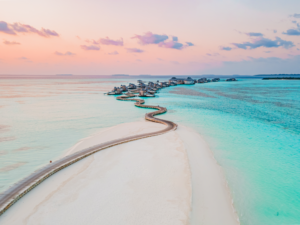
Forty percent of all Maldivians are squeezed into Malé’s tiny metropolis, one of the world’s smallest capitals – an 8.3km² island packed with sights and artificial beaches. It takes approximately two hours to walk across from east to west. English – the country was colonised by the UK until 1965 – is the lingua franca, though Maldivians have their own language, Dhivehi.
Tiny though it might be in native population, this crystalline ocean-world is overloaded with rich indigenous culture, including its own currency (the rufiyaa), dialects and citrusy cuisine – largely from the sea’s bounty; think snapper or trevally fish. If available, ask for kandu kukulhu riha (yellowfin tuna curry), tuna-and-coconut mas huni and spicy kulhi kaaja snacks; and if you only learn one Dhivehi phrase, make it varah meeru (“very tasty”) – it’ll soon become obvious why.
Dubai, Sri Lanka and Thailand necessarily export food to the Maldives’ cosmopolitan resorts. Though fruit and vegetables are in ample supply, lawmakers have wisely banned fishing for blacktip reef sharks, spinner dolphins and moray eels. This preserves the country’s already mind-boggling biodiversity: hawksbill turtles, barracudas, grey herons, giant eagle rays, noisily cawing crows, manta rays and tropical fish schools. You’ll also hear traditional boduberu music gracing the airwaves, and if you can, sail aboard an ornate dhoni, a colourful, distinctively shaped fishing boat.
An ideal way to experience the Maldives is a stay at an all-inclusive resort, where you largely don’t have to worry about running a high tab on meals and activities, most of which will already be tucked into the price of the room or villa. Club Med pioneered this concept in the 1950s, and has kept that spirit alive at Club Med Kani, a short 30-minute speedboat ride from the airport.
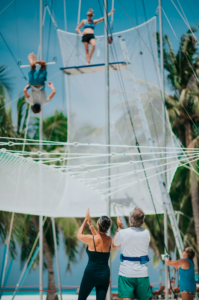
A popular choice for families eager to snorkel among coral reefs and enjoy water sports, it also hosts the pricier Manta Exclusive Collection, a 70m² adults-only space with more than 60 overwater wooden stilts, each offering butler service. According to Rachael Harding, CEO of Club Med for East, South Asia and Pacific, Manta offers “an elevated level of personalisation and service that really leans on the trend that is luxury travel with a difference.” The hospitality group is also gearing up to open its first property in Malaysia next year, in Kota Kinabalu on Borneo island.
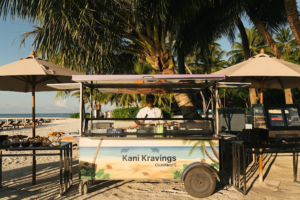
The relatively simplified set-up of Club Med Kani feels rather refreshing, with just two restaurants – The Kandu and The Vehli – offering buffet spreads and a la carte menus respectively; pampering at a spa; and the blissful release of lazing the day away on a white-sand beach. Excursions include day-tripping to Malé, an option offered by few Maldivian resorts, a “lobster picnic” and an array of land-based leisure sports (padel tennis, anyone?) and Club Med’s signature trapeze, as well as more strenuous aquatic adventures.
Further along the luxe scale is Conrad Maldives Rangali Island. Last year, the property completed sweeping renovations led by the esteemed New York-based Japanese architect Yuji Yamazaki. “The vision,” says general manager Thomas Hoeborn, “was to elevate each guest’s experience by blending seamless indoor-outdoor living, sustainable practices and timeless elegance, ensuring that the natural beauty of the Maldives remains central to the experience.”

The Conrad pioneered the underwater-villa concept with The Muraka, which to date only one other resort (Pullman Maldives Maamutaa) has emulated. This oneiric experience allows six people to fully immerse in the sub-aquatic universe swimming silently mere metres away. Sitting pretty in South Ari Atoll, a half-hour seaplane flight from Malé, visitors may choose between beach villas with outdoor bathrooms or plunge pools, and interconnected overwater villas.
There’s an emphasis on enjoying the sea and its various inhabitants – one notable tour is the whale-shark yacht excursion, where guests search for this majestic species prevalent in local waters, then enjoy swimming alongside the gentle giant. As you enjoy champagne and canapés, you may also find playful dolphins somersaulting through the Indian Ocean. There are also turtle tours and sunset fishing boat trips that offer the opportunity to catch your own seafood dinner.
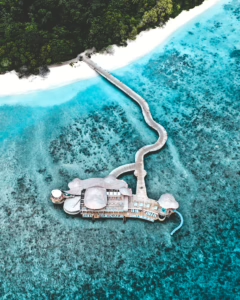
Another resort is Soneva Fushi, and although more remote, has plenty to keep everyone busy. It’s perfect for multigenerational travel, featuring South Asia’s biggest kids’ club (The Den) alongside 63 villas strung across the white-sand beach, lush gardens and huge Water Reserve residences on Unesco-protected Baa Atoll’s Kunfunadhoo Island. It’s one of four sustainable properties under the Soneva brand name – alongside Jani in Noonu Atoll; the brand-new, ultra-personalised 14-villa Soneva Secret on Makunudhoo Atoll; and the Kiri beach resort in southern Thailand. The prestigious chain is known for its focus on both local and international experiences, such as visiting Michelin-star chefs and sports stars.

The phrase “barefoot luxury” might sound cliché, yet perfectly describes Soneva Fushi, where every villa comes with a 24/7 “Barefoot Guardian” and guests need never don shoes. The brilliant water slides into the ocean affixed to the Water Reserves are just the start; the two-storey “Crusoe” residence comes with a steam room, of all things, while the Sunset Reserve sprawled around a superannuated banyan tree is fitted with swings.
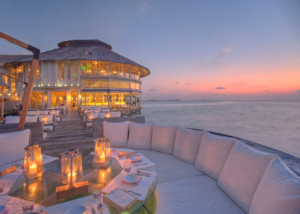
Padel tennis courts, the Maldives’ first zipline and trending Seabob motorised watercrafts top the list of exhilarating activities, while 11 dining destinations are dotted around Soneva Fushi, all innovative in their own way, are blessed with pun-tastic names like Carne Diem, Flying Sauces and Once upon a Table. Soneva’s eco-efforts aren’t to be sniffed at; it partners with NGO Save Our Seas and the Olive Ridley Project, while its own foundation helps grow coral reefs.
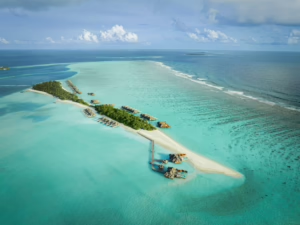
The Maldives is also gaining popularity among wellness seekers. “[It’s] a new destination for wellness,” says Jeneena Schatz, marketing and PR manager for Joali Being, a whole resort designed around well-being programmes, a first in the Maldives. “The nature, peace and clean air, along with the hospitality of the Maldives, attract a number of travellers.” Joali Being, a true resort original, arrived as “mindfulness” and “responsible travel” became buzzwords in 2021 – a “well-being island” set on calm, secluded Bodufushi in Raa Atoll. Its ethos has four central pillars: mind, skin – think anti-ageing treatments – microbiome (the interaction of a community) and energy.
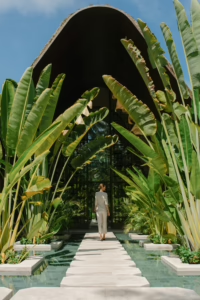
“It all began with spa treatments that evolved into more,” says Jeneena, who adds that the resort recognises the rise of a particular type of traveller: the leisure and wellness seeker. “Wellness for us isn’t just a one-time detox; it’s a way of life where your daily food, physical activities and experiences are centred around healthy habits.” Balm for the soul, its 68 distinctive villas are built to biophilic design principles, leading to not merely a satisfying night’s sleep but a feeling of fulfilment on waking. The experiential resort is centred around giving its guests what it calls “weightlessness” – a sense of freedom, lightness and joy.
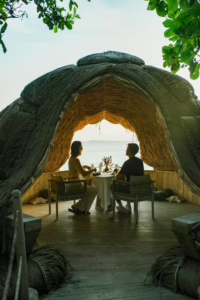
Holistic well-being is the ultimate aim, taking those who stay at Joali on an immersive journey of self-discovery and renewal in the calm surrounds of nature. It’s a paradigm that even extends to the wide selection of sustainably sourced food-and-drink venues on offer, which include options for all possible tastes; “earth-to-table”, pescetarian, Japanese and Mediterranean cuisines.
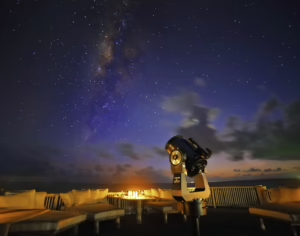
As W Maldives prepares to open next month on North Ari Atoll, promising 77 villas, eclectic dining and sustainability initiatives, the country is undergoing a transformative moment. Wherever you choose to stay in the Maldives, you’ll witness breathtaking sunsets that shift from orange to red to purple, and a spotlessly clear, unpolluted night sky twinkling with brilliant stars – scenes that would bedazzle even the most hard-bitten traveller with the sheer wonderment of it all.



